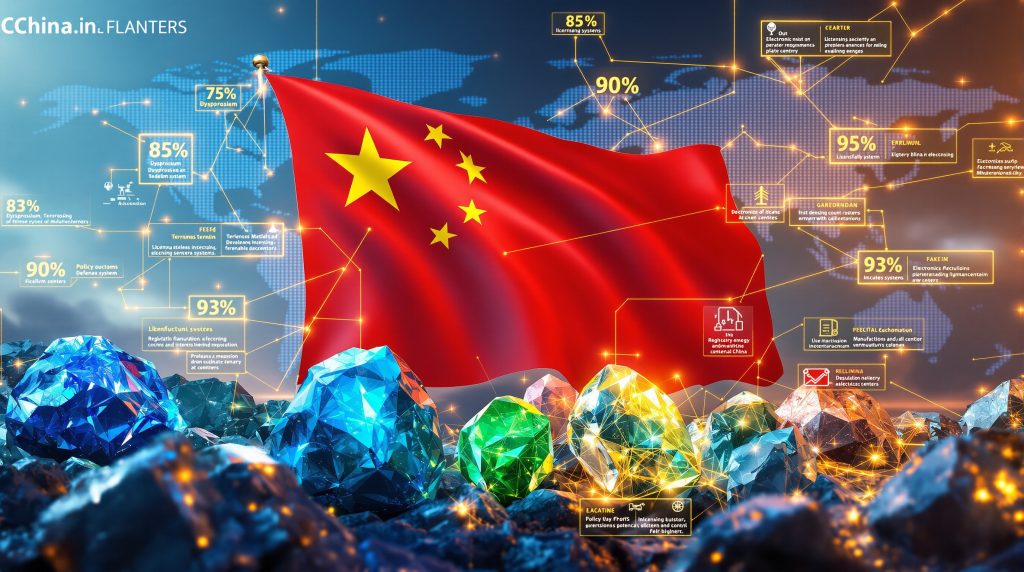Understanding China's Strategic Export Control Framework
China's rare earth export control measures represent a sophisticated regulatory system designed to manage the flow of critical minerals essential for modern technology manufacturing. These controls operate through a comprehensive licensing mechanism that grants Beijing significant discretionary power over global supply chains, affecting industries from renewable energy to defence manufacturing across multiple continents.
The control framework encompasses both direct restrictions on raw materials and downstream products, creating multiple leverage points throughout the supply chain. Unlike traditional trade barriers, these measures function as strategic tools that can be calibrated based on geopolitical considerations and economic objectives, allowing China to maintain plausible compliance with international trade norms whilst exercising strategic control.
Beijing's approach institutionalises discretion through bureaucratic processes that can throttle supply without implementing outright embargoes. Furthermore, this sophisticated system enables Chinese authorities to evaluate each shipment's end use and destination, demanding extensive documentation and technology transfer disclosures that can extend approval timelines by several months.
How China's April 2025 Export Licensing Requirements Work
On April 4, 2025, China implemented Ministry of Commerce Regulation No. 61, placing seven categories of medium and heavy rare earth elements under strict export licensing control. This regulatory framework targets materials vital for defence and high-tech applications, creating a system where exporters must seek case-by-case government approval for overseas shipments.
Key Elements Under Control:
• Dysprosium and terbium (critical for high-performance permanent magnets)
• Samarium and gadolinium (essential for defence radar systems)
• Lutetium, scandium, and yttrium (specialised technology applications)
The licensing process involves multiple bureaucratic layers and extensive documentation requirements. However, Chinese authorities possess broad latitude to evaluate applications based on national security considerations, requiring detailed end-user certificates and comprehensive technology transfer disclosures before approval.
Licensing Process Characteristics:
| Aspect | Requirement |
|---|---|
| Documentation | Detailed end-user certificates and technology disclosures |
| Processing Time | 2-6 months average timeline |
| Approval Authority | Ministry of Commerce (MOFCOM) |
| Review Criteria | National security and dual-use assessment |
| Renewal Frequency | Per-shipment basis with recurring evaluations |
This framework allows Beijing to appear compliant with international trade norms whilst selectively tightening supply whenever geopolitically convenient. Consequently, the discretionary nature enables Chinese authorities to effectively throttle rare earth exports without announcing explicit bans, creating uncertainty for Western buyers dependent on these critical materials.
What Changed with China's October 2025 Export Control Expansion
The October 9, 2025 measures marked a dramatic escalation, introducing extraterritorial jurisdiction concepts previously associated with export controls on critical minerals. These new regulations expanded coverage to include holmium, erbium, thulium, europium, and ytterbium, bringing twelve of the seventeen rare earth elements under Chinese export restrictions.
Revolutionary Extraterritorial Provisions:
• De Minimis Rule: Foreign products containing ≥0.1% Chinese rare earth content by value require Chinese export licences
• Foreign Direct Product Rule: Items manufactured using Chinese rare earth technology face licensing requirements regardless of material origin
• Military End-User Restrictions: Presumptive denial for overseas defence contractors and military-affiliated entities
Article 1(1) of MOFCOM's Announcement No. 61 introduced sweeping extraterritorial reach, asserting Chinese jurisdiction over foreign-made rare earth magnets or materials containing even trace amounts of Chinese-origin content. In addition, this means Japanese magnet manufacturers or American defence contractors using minimal Chinese dysprosium could become subject to Chinese regulatory control.
The Foreign Direct Product rule extended controls to items manufactured with Chinese rare earth technology, including mining, processing, or magnet-making knowledge, even when containing no Chinese materials. These measures effectively asserted China's right to licence and veto foreign downstream products, representing unprecedented extraterritorial reach into global supply chains.
Beijing also announced presumptive licence denials for overseas end-users with military affiliations, effectively creating a rare earth embargo on foreign defence contractors. These rules were scheduled for implementation in November 2025 for new elements and December 1, 2025 for foreign-entity provisions.
Why the October 2025 Busan Agreement Created Strategic Ambiguity
The October 30, 2025 agreement between Presidents Trump and Xi Jinping resulted in what industry analysts describe as a tactical pause rather than a genuine policy reversal. China agreed to suspend implementation of relevant export control measures for one year, but the deliberately vague language preserved significant flexibility for Beijing's interpretation.
What Was Actually Suspended:
• New element additions scheduled for November 2025
• Extraterritorial jurisdiction rules set for December 2025
• Enhanced military end-user restrictions targeting foreign defence contractors
What Remained in Force:
• April 2025 licensing system for seven critical rare earth elements
• Existing bureaucratic approval processes and documentation requirements
• Discretionary authority over export permits and case-by-case evaluations
The strategic ambiguity in the agreement's language allows China to interpret relevant measures according to its own interests, maintaining leverage whilst appearing cooperative. Beijing's Foreign Ministry notably omitted specific mention of rare earths from formal announcements, signalling this was not a permanent policy shift but rather a calculated timeout.
The suspension's wording gives China flexibility to reinstate restrictions at will, effectively holding leverage over the global supply chain whilst maintaining diplomatic reasonableness.
This diplomatic manoeuvring demonstrates sophisticated strategic thinking that preserves long-term advantages whilst providing short-term relief to international markets and reducing immediate U.S. pressure for retaliation.
How These Controls Impact Global Supply Chain Dependencies
China's dominance extends far beyond raw material extraction, encompassing the entire rare earth value chain through what industry experts call the chemistry problem. The country controls approximately 85-90% of global rare earth refining capacity and an estimated 93% of high-performance magnet production, creating multiple chokepoints that export controls can exploit effectively.
Critical Dependency Points:
| Supply Chain Stage | Chinese Market Share | Western Alternatives |
|---|---|---|
| Raw Material Mining | ~60% | Mountain Pass (USA), Lynas (Australia) |
| Refining and Separation | 85-90% | Limited pilot projects under development |
| Magnet Production | 93% | Emerging facilities in Texas and Europe |
| Heavy Rare Earth Processing | ~95% | No commercial-scale alternatives operational |
The processing bottleneck represents the most significant vulnerability for Western supply chains. Even materials mined in the United States or Australia typically require Chinese refining capabilities for separation into individual rare earth elements. This dependency means that geographical diversification of mining operations provides limited protection against china's rare earth export control measures.
Heavy rare earth separation presents particular challenges, requiring specialised chemical processes and extensive technical expertise that currently exists at commercial scale only in China. Elements like dysprosium and terbium, essential for high-performance permanent magnets, cannot be processed elsewhere at the volumes required by global manufacturing.
The magnet manufacturing dependency creates additional vulnerability, as even access to refined rare earth materials does not guarantee the ability to produce the sophisticated permanent magnets required for electric vehicles, wind turbines, and defence systems. Chinese manufacturers have decades of accumulated expertise in magnet production techniques that Western competitors are still attempting to replicate.
What Are the Geopolitical Implications of Rare Earth Weaponisation
China's rare earth export control measures represent a strategic response to us-china trade war impact, demonstrating how critical mineral dependencies can be leveraged for geopolitical advantage. This approach mirrors American semiconductor export controls but exploits China's upstream dominance in raw materials rather than downstream technological superiority.
The measures create asymmetric pressure on Western economies, particularly affecting sectors crucial for energy transition and national security objectives. Electric vehicle manufacturers, wind turbine producers, and defence contractors face potential supply disruptions that could compromise both economic competitiveness and strategic military capabilities.
Sectoral Impact Analysis:
• Defence Industry: Guided missile systems, radar technology, and electronic warfare capabilities depend heavily on controlled rare earth elements
• Renewable Energy: Wind turbines and electric vehicle motors require specific magnetic materials under Chinese export control
• Electronics Manufacturing: Consumer devices, telecommunications equipment, and computing hardware incorporate multiple controlled elements
Beijing's strategy effectively flips the script on U.S. export control tactics, using China's mineral processing dominance similarly to how America leverages semiconductor chokepoints. This creates a new dynamic in great power competition where resource control becomes as strategically important as technological advancement.
The extraterritorial aspects of China's October 2025 measures particularly demonstrate sophisticated understanding of global supply chain vulnerabilities. By asserting jurisdiction over foreign companies using even minimal Chinese content, Beijing attempted to extend its regulatory reach into allied nations' defence and technology sectors.
How Defense Industries Navigate Supply Chain Vulnerabilities
The integration of rare earth elements into modern defense materials strategies creates particular vulnerabilities for military procurement systems. Advanced weapons systems, radar arrays, and electronic warfare platforms depend on specific magnetic properties that can only be achieved through heavy rare earth elements like dysprosium and terbium.
Military contractors face the challenging reality that alternative materials often compromise performance characteristics essential for national security applications. Furthermore, the specialised nature of defence requirements means that stockpiling becomes more complex than civilian applications, requiring careful coordination between military planners and supply chain managers.
How Effective Are Current Western Mitigation Strategies
Western responses to china's rare earth export control measures have focused on supply chain diversification, strategic stockpiling, and alternative technology development. However, these efforts face significant technical, financial, and temporal challenges that limit their effectiveness in addressing immediate vulnerabilities or medium-term supply security needs.
Mitigation Approach Assessment:
Strategic Stockpiling Initiatives
Government reserves in the United States, Japan, and European Union provide temporary buffers during supply disruptions but cannot sustain industrial production over extended periods. Current stockpile sizes typically support 90-180 days of consumption, insufficient for prolonged trade conflicts or extended processing capacity development.
Strategic stockpiling provides crucial emergency reserves but cannot address fundamental supply chain dependency issues or support sustained manufacturing operations during extended disruptions.
Alternative Supply Development Projects
• MP Materials (USA): Expanding operations from mining at Mountain Pass to integrated magnet production
• Lynas Corporation (Australia): Establishing U.S. heavy rare earth processing capabilities in Texas
• European initiatives: REE4EU programme targeting comprehensive supply chain independence by 2030
• Canadian projects: Multiple mining ventures targeting heavy rare earth deposits
These projects represent important progress toward supply diversification but remain years from commercial-scale operation capable of meaningfully reducing Chinese dependency. The technical complexity of heavy rare earth separation and specialised magnet manufacturing creates barriers that cannot be overcome through financial investment alone.
Technology Substitution Research
Advanced research programmes focus on developing rare earth-free permanent magnets and alternative materials for critical applications. However, current substitute materials typically offer significantly reduced performance characteristics, making them unsuitable for demanding applications like electric vehicle motors or wind turbine generators.
Industry experts estimate 5-10 years minimum timeline for establishing commercially viable Western rare earth processing capabilities, with heavy rare earth separation requiring even longer development periods due to technical complexity and limited expertise outside China.
What Does the Future Hold for Rare Earth Export Controls?
The one-year suspension negotiated in Busan provides temporary respite whilst underlying strategic competition continues intensifying. China's willingness to pause rather than eliminate controls suggests confidence in its long-term market position and recognition that Western supply chain alternatives remain insufficient to challenge Chinese dominance.
Potential Future Scenarios:
• Graduated Reintroduction: Selective restoration of export controls based on geopolitical developments and bilateral relationship status
• Technology-Focused Restrictions: Emphasis on downstream applications and processing technology rather than raw material exports
• Multilateral Coordination: Potential cooperation with Russia and other mineral-rich nations to enhance collective leverage over Western consumers
The suspension period offers Western nations a critical window to accelerate supply chain diversification efforts, but success requires sustained political commitment and substantial financial investment across multiple countries. Without meaningful progress during this grace period, future China's rare earth export control measures could prove significantly more disruptive to global manufacturing.
Trump Administration's Policy Response
The trump order on minerals represents a significant shift in U.S. strategic thinking about supply chain vulnerabilities. These executive actions demonstrate recognition that traditional market mechanisms may be insufficient to address state-directed export controls in critical mineral sectors.
Moreover, the policy framework established by these orders creates institutional mechanisms for coordinating government and private sector responses to supply chain disruptions. This represents a departure from previous market-oriented approaches toward more strategic government intervention in critical material supply chains.
Market Psychology Considerations
Industry decision-makers now factor potential Chinese export disruptions into long-term planning, creating incentives for supply chain diversification even during periods of stable access. This psychological impact may accelerate Western investment in alternative supply sources beyond what purely economic factors would justify.
How Should Industries Prepare for Ongoing Supply Chain Uncertainty?
Companies dependent on rare earth materials must develop comprehensive risk management strategies that account for potential future restrictions whilst managing current operational requirements. This preparation involves both immediate operational adjustments and long-term strategic planning across multiple scenarios.
Risk Mitigation Strategies:
| Timeframe | Recommended Actions |
|---|---|
| Immediate (0-12 months) | Inventory optimisation, supplier diversification, contract renegotiation |
| Medium-term (1-3 years) | Alternative material research, long-term supply agreements, processing partnerships |
| Long-term (3-10 years) | Vertical integration, technology substitution, regional supply chain development |
Immediate Operational Adjustments
• Inventory Management: Increase strategic inventory levels for critical rare earth materials whilst balancing carrying costs
• Supplier Diversification: Establish relationships with multiple suppliers across different geographical regions
• Contract Structure: Negotiate force majeure clauses and alternative sourcing provisions in supply agreements
• Price Hedging: Implement financial instruments to manage rare earth price volatility during supply disruptions
Long-term Strategic Planning
Industries should monitor geopolitical developments that could trigger renewed restrictions, including Taiwan Strait tensions, technology export disputes, and broader U.S.-China strategic competition dynamics. Early warning systems and scenario-based contingency planning become essential for maintaining operational continuity.
Understanding critical minerals & energy security becomes crucial for companies operating in the renewable energy sector. The intersection of supply chain vulnerability and energy transition objectives creates complex planning challenges that require integrated approaches across multiple stakeholder groups.
Geological Investment Considerations
Understanding rare earth deposit characteristics becomes crucial for evaluating alternative supply sources. Heavy rare earth elements like dysprosium and terbium occur in much lower concentrations than light rare earths, requiring specialised extraction and processing techniques that significantly impact project economics and development timelines.
Mineral Grade Quality Assessment:
Western rare earth projects often feature different ore compositions compared to Chinese deposits, affecting processing complexity and final product specifications. Companies must evaluate whether alternative sources can meet specific technical requirements for high-performance applications.
What Role Do Rare Earth Controls Play in Broader Strategic Competition?
China's rare earth export control measures represent one element of a comprehensive strategic competition involving critical technologies, supply chain security, and economic interdependence. These measures demonstrate how resource control can complement technological capabilities in geopolitical competition, creating asymmetric pressure points that traditional military or economic tools cannot address.
The effectiveness of rare earth leverage depends fundamentally on maintaining processing dominance whilst Western alternatives remain underdeveloped. This dynamic creates powerful incentives for continued Chinese investment in refining capacity and magnet production technology, potentially widening competitive gaps despite Western diversification efforts.
Integration with Industrial Policy
Beijing's rare earth controls align with broader Made in China 2025 objectives, supporting domestic value-added manufacturing whilst constraining foreign competitors' access to critical inputs. This strategy enables China to move up the value chain whilst maintaining control over upstream dependencies.
The measures also complement China's broader Belt and Road Initiative by positioning Chinese rare earth processing capabilities as essential infrastructure for participating nations' industrial development. Consequently, this creates additional diplomatic leverage beyond purely economic considerations.
Understanding Global Rare Earth Distribution
The global distribution of rare earth reserves analysis reveals significant geographical concentration that enables strategic leverage by resource-controlling nations. This concentration creates inherent vulnerabilities that cannot be easily addressed through market mechanisms alone.
Furthermore, the geological reality of rare earth distribution means that certain strategic elements remain concentrated in specific regions, creating permanent dependencies that require careful diplomatic and strategic management rather than simple supply diversification approaches.
Financial Market Implications
Rare earth export controls create significant volatility in related equity markets, affecting everything from mining companies to electric vehicle manufacturers. Understanding these dynamics becomes crucial for investors seeking to navigate supply chain risks and identify opportunities in alternative supply development.
The threat of export controls also influences capital allocation decisions, with Western governments and private investors increasingly prioritising supply chain resilience over pure cost optimisation. This shift may fundamentally alter global rare earth investment patterns and project development priorities.
Conclusion: Navigating the New Reality of Resource Geopolitics
Understanding china's rare earth export control measures requires recognising their integration with broader Chinese industrial policy, technological development strategies, and geopolitical objectives. The rare earth sector serves simultaneously as an economic asset and a strategic instrument in the evolving landscape of great power competition, where control over critical minerals becomes as important as technological superiority.
Regulatory Evolution Expectations:
Future Chinese rare earth policies will likely become more sophisticated, incorporating lessons learned from the initial implementation phases and international responses. This evolution may include dynamic licensing systems that adjust automatically based on geopolitical indicators, more precise targeting of specific applications, and enhanced coordination with other critical mineral export controls.
The precedent established by china's rare earth export control measures may encourage other resource-rich nations to develop similar strategic leverage tools, potentially creating a more fragmented and politically influenced global minerals market that challenges traditional free trade assumptions.
In addition, companies and governments must recognise that the era of purely market-driven mineral supply chains has ended, replaced by a more complex reality where geopolitical considerations increasingly influence resource access and pricing. Success in this environment requires sophisticated understanding of both technical supply chain vulnerabilities and the political dynamics that increasingly shape global mineral markets.
Ready to Navigate the Next Wave of Critical Mineral Disruptions?
Discovery Alert's proprietary Discovery IQ model delivers real-time alerts on significant mineral discoveries across the ASX, helping investors identify opportunities in rare earth alternatives and critical mineral projects before broader market awareness. With China's export controls creating unprecedented volatility and Western supply chain diversification accelerating, begin your 30-day free trial today to stay ahead of the rapidly evolving critical minerals landscape.




